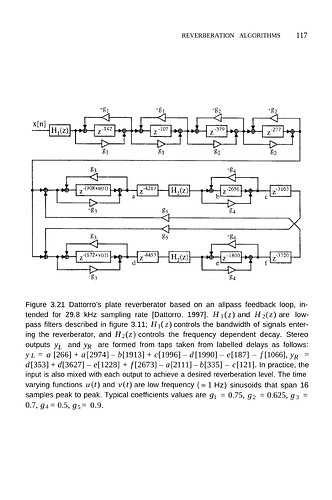Hi, I’m trying to get a bit more into reverb theory and have been copying a few old algorithms from papers. I’m struggling now with a slightly more complex algorithm and hoping someone here could help me out.
Here’s the algorithm:
And here’s my attempt to code it - I have a feeling there might be a few pretty basic mistakes in there!
(
SynthDef(\test, {
var sig = Saw.ar(XLine.kr(1000, 100, 1) + [0, 1]) * Env.perc(0.01, 1).ar(Done.freeSelf);
sig = sig * -20.dbamp;
Out.ar(0, sig);
}).add;
SynthDef(\dattorro, {
var fb;
var input = In.ar(0, 2);
var sum = 0;
var allpassTimes = [142, 107, 379, 277] / 29800;
var lfo = 2.collect { SinOsc.kr(rand(0.99, 1.01)) * 16/29800 };
var sig = LPF.ar(input, 8000);
// 4 Allpass in series
4.do { |i|
sig = AllpassC.ar(sig, 1, allpassTimes[i], 1);
};
// fb loop starts here
fb = sig + LocalIn.ar(2);
fb[0] = AllpassC.ar(fb[1], 1, 908/29800 + lfo[0]);
fb[0] = CombC.ar(fb[0], 1, 4127/29800);
fb[0] = LPF.ar(fb[0], 8000);
fb[0] = AllpassC.ar(fb[0], 1, 2656/29800);
fb[0] = CombC.ar(fb[0], 1, 3163/29800);
fb[1] = AllpassC.ar(fb[0], 1, 672/29800 + lfo[1]);
fb[1] = CombC.ar(fb[1], 1, 4453/29800);
fb[1] = LPF.ar(fb[1], 8000);
fb[1] = AllpassC.ar(fb[1], 1, 1800/29800);
fb[1] = CombC.ar(fb[1], 1, 3720/29800);
LocalOut.ar(fb);
sig = input + (fb * -80.dbamp);
//sig = sig * \amp.kr(-80.dbamp);
ReplaceOut.ar(0, sig);
}).add;
)
x = Synth.tail(nil, \dattorro);
Synth(\test);
Cheers,
Jordan
